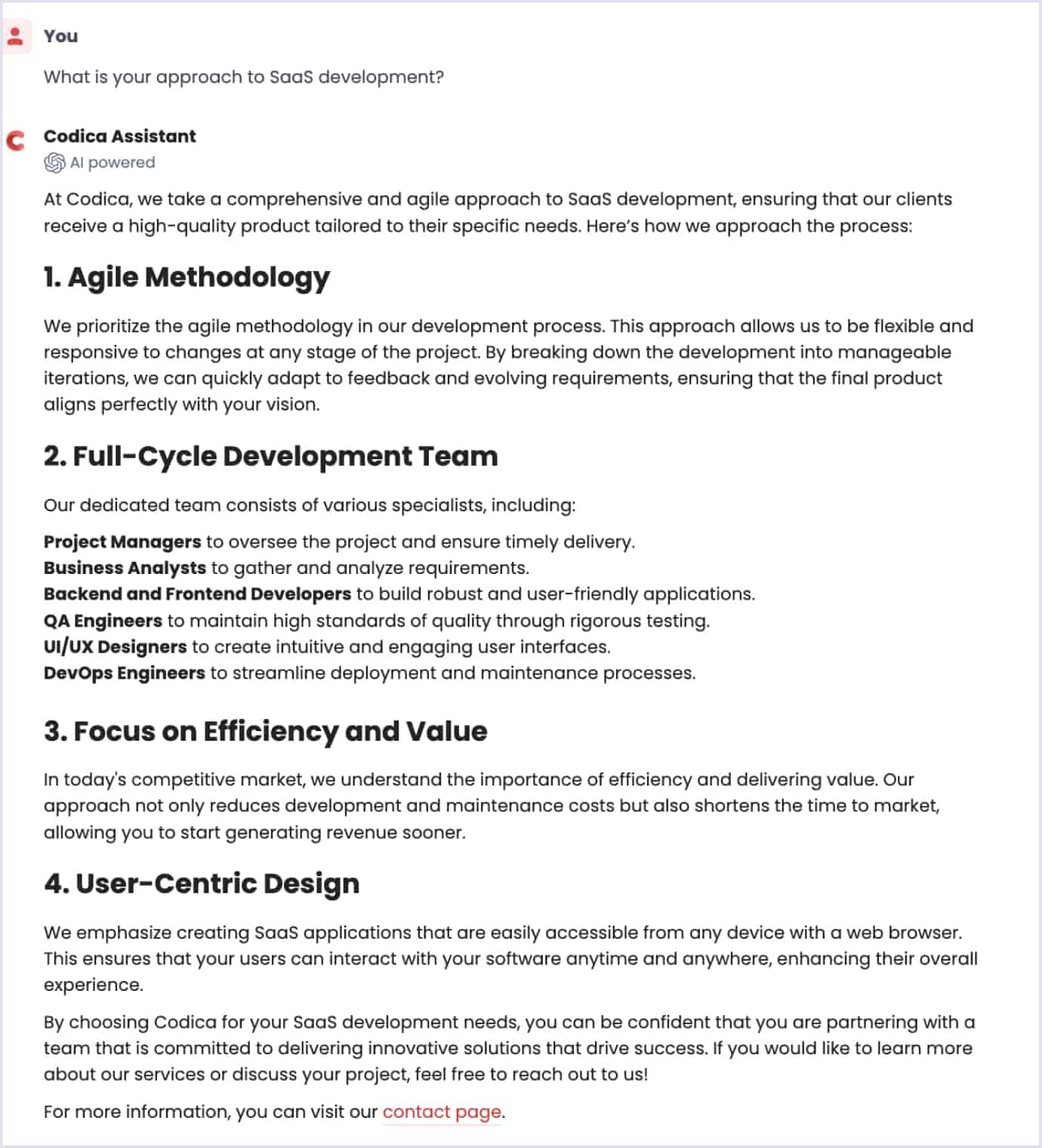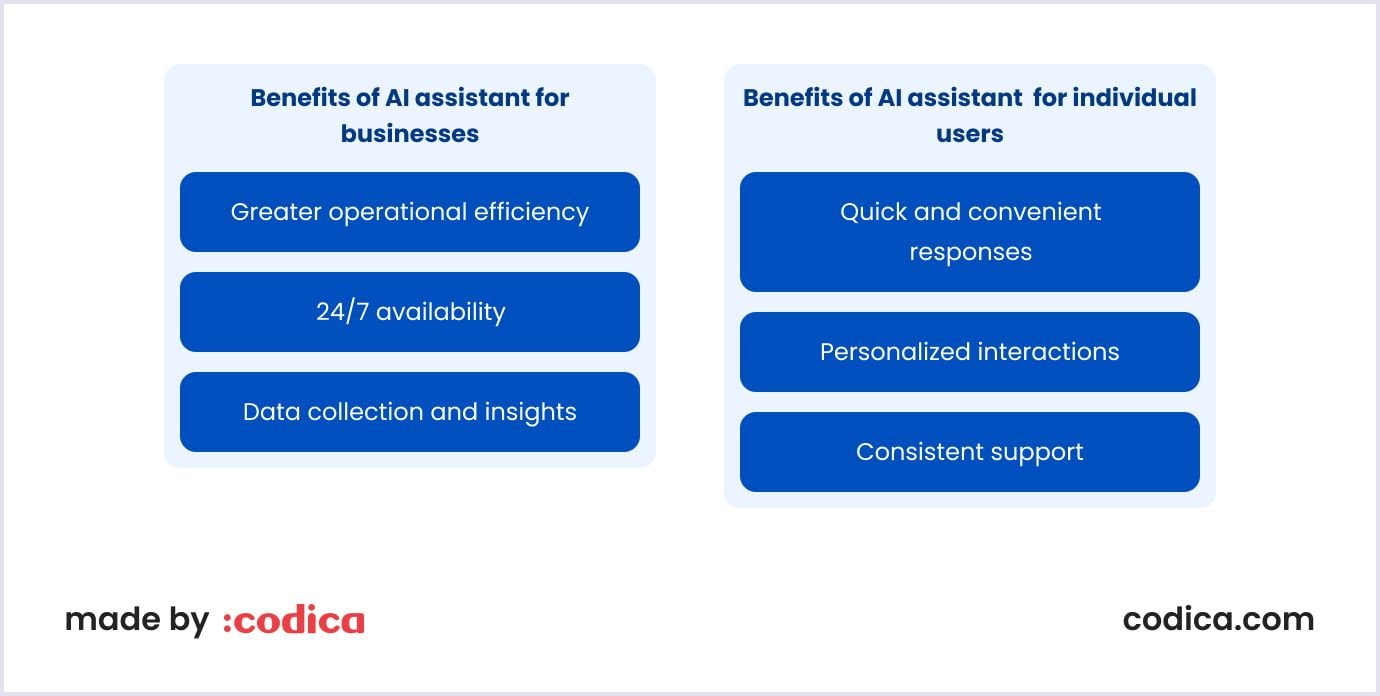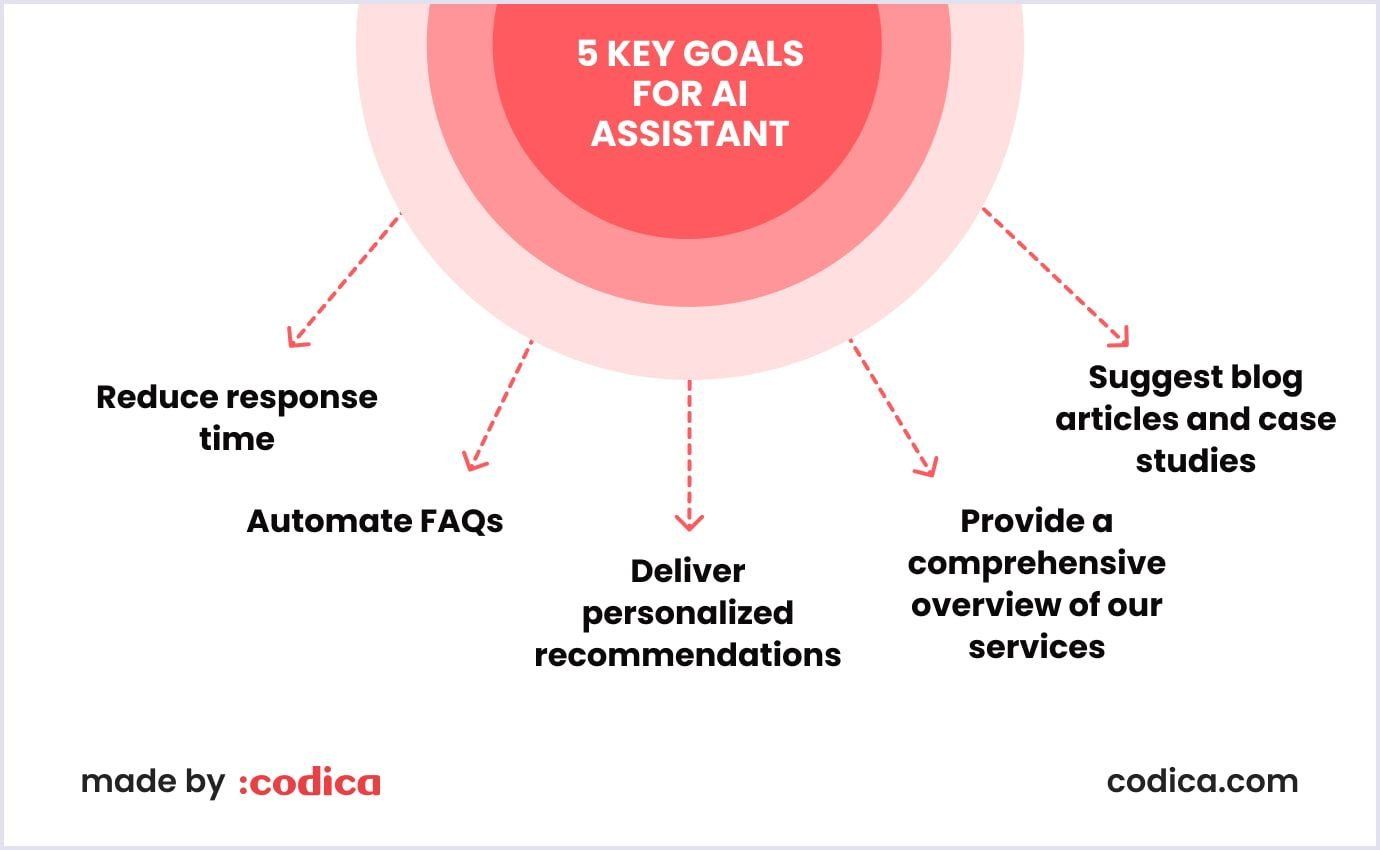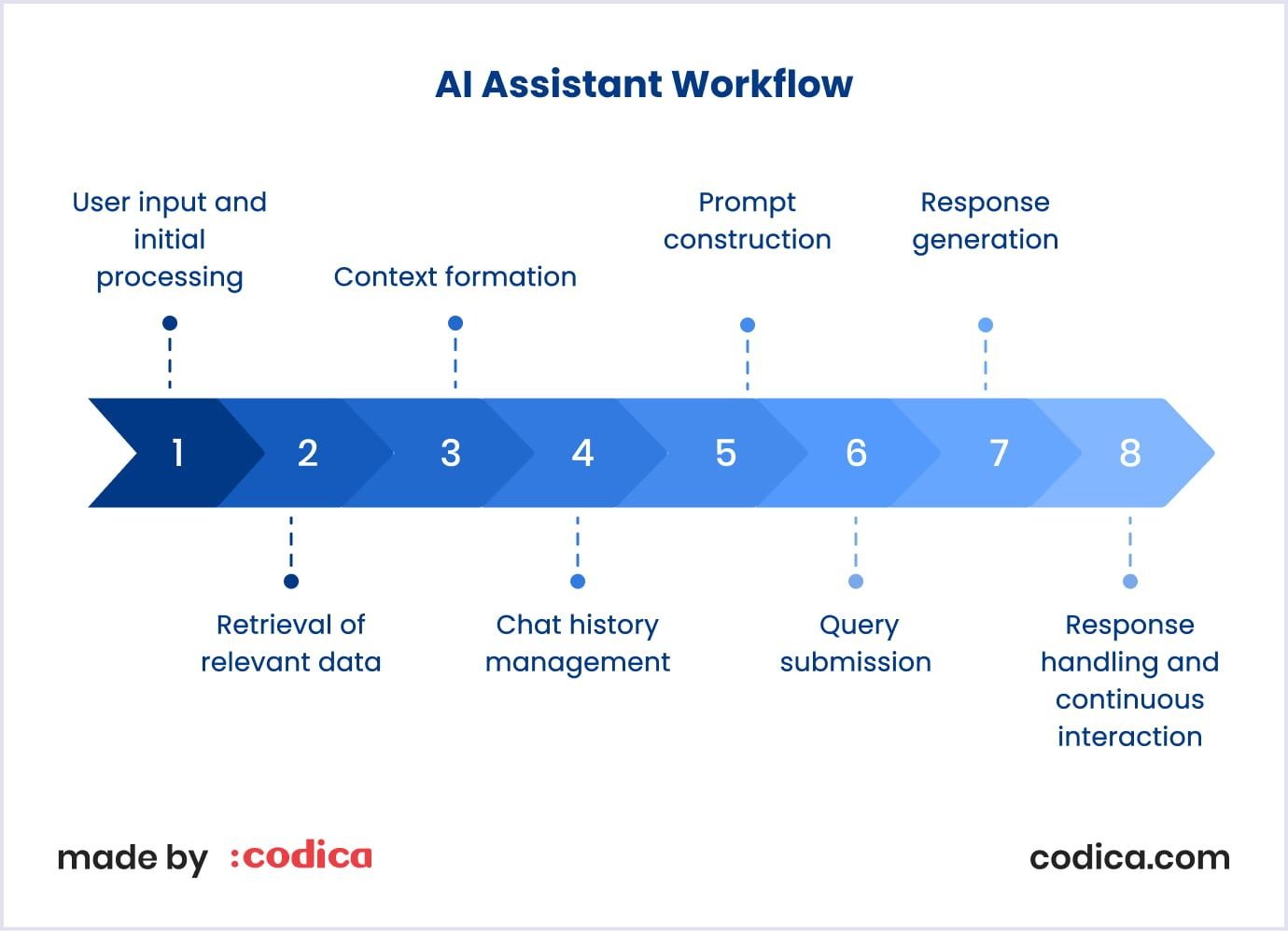As you may already know, artificial intelligence paves the way for business innovation. Nowadays, with increased accessibility and demand, businesses create various AI solutions to improve all sorts of their operations.
One such solution is an AI assistant, which is capable of a lot. At Codica, no trends move past us, so we made our very own AI-powered assistant. Today, we’ll share our experience developing AI solutions, especially an AI assistant. We’ll cover the idea behind it, the benefits it brings, and explain in greater detail how it works.
Why an AI assistant?
Naturally, our expertise is multifaceted, as we provide all sorts of custom development services to our clients. Namely, we are experts in building custom marketplaces, creating MVP, SaaS solutions, and much more. Besides, we employ our expertise in many domains. With such a broad expertise range, categorization and some kind of order is paramount.
Our clients, be they startup founders or well-established business owners, may not have enough time to study through our website if they’re interested in our services. Consequently, bits of important information are left unnoticed, which is bad, both for us and for them.
For this exact reason, our AI assistant has been built. It lets our clients get a breakdown of any of our services, articles, and case studies in a matter of seconds. AI, in turn, makes sure to provide all the necessary information about our expertise, including relevant links, tips, and suggestions. Here’s a neat example:

TL;DR, our AI assistant features several important benefits. For us, as a software development company, it brings:

- Greater operational efficiency. Our assistant helps automate routine tasks like answering frequently asked questions and providing detailed info on the services, allowing our team to focus on more complex and intricate requests.
- 24/7 availability. With an AI assistant, our clients can receive all the information they need round-the-clock. This way, we can effectively assist our clients who live in different time zones.
- Data collection and insights. Our AI assistant knows which questions are popular and what people ask frequently. With this information, we can refine our services to make them more detailed and understandable.
On the other hand, it’s beneficial for our clients, namely the people who visit our website and decide to use an AI assistant to get to know Codica better. Therefore, here are the benefits it brings to our clients:
- Quick and convenient responses. The assistant provides instant answers to common questions, reducing wait times and improving the overall customer experience. Besides, it greatly simplifies finding information on our website, making it more user-friendly.
- Personalized interactions. With an AI assistant, we can deliver personalized recommendations and support based on customer intentions and requests.
- Consistent support. It reduces the frustration of inconsistent information, providing reliable assistance every time. Besides, AI also makes our website more accessible to users with different needs by offering premade text options and multilingual support.
Planning and strategy
When planning the integration of our AI assistant, it was essential to define clear objectives to guide the development process. We identified five key goals that would drive the design and implementation of the AI assistant.

1. Reduce response time
One of our primary objectives was to reduce the response time for clients interested in our services. By automating the initial interaction with users, the AI assistant could provide immediate responses to common questions, minimizing the time customers spend waiting for assistance.
2. Automate FAQs
We aimed to automate the handling of frequently asked questions (FAQs), which often constitute a large portion of client inquiries. Therefore, our AI assistant was designed to provide accurate, consistent answers to these questions, freeing up our sales team to focus on more complex issues.
3. Deliver personalized recommendations
To further improve the experience, we wanted the AI assistant to offer personalized recommendations based on clients’ interests. As a result, our assistant can suggest relevant services, case studies, and blog articles to provide more information.
4. Provide a comprehensive overview of our services
We sought to ensure that the AI assistant could provide a thorough overview of all the services we offer. Whether a potential client is exploring our website for the first time or an existing customer is looking for more information, the AI assistant was designed to guide users through our service offerings, answering questions and providing details as needed.
5. Suggest blog articles and case studies
Recognizing the value of content in driving customer engagement, we wanted the AI assistant to suggest relevant blog articles based on clients' questions.
Choosing the right AI technology
Selecting the right AI technology was a critical decision in the planning phase. We needed a solution that was not only powerful and capable of meeting our objectives but also flexible and easy to integrate into our existing tech stack.
Codica AI assistant is based on the large language model (LLM). While traditional LLMs work by processing input text and generating output text, the chat model goes further by processing messages. These messages consist of content and roles that indicate the author, whether a human, AI, or system.
Regarding the details, we decided to use GPT-4o-mini, which is a version of the GPT model developed by OpenAI. This model specifically offers robust conversational capabilities, allowing the assistant to understand a variety of user requests and respond to them efficiently.
Besides, an assistant was designed with scalability in mind, allowing us to expand its capabilities as our company grows and needs change.
How it works
Moving from the theory, let’s see how everything coherently works together to deliver what is known as an AI assistant.
First of all, Codica AI assistant works on the principle of LangChain. This concept combines external data sources and computation with a Large Language Model. This allows to create logical sequences of operations, known as chains, that guide the assistant's behavior. Therefore, it uses a series of organized steps, including:
- Input data processing;
- Vector embedding generation;
- Semantic search;
- Contextualization;
- Answer generation.
As a result, Codica AI assistant provides intelligent and contextually relevant answers to user queries. With the LangChain concept, the assistant combines multiple operations into coherent sequences, enriching its conversational capabilities and increasing user engagement.
Apart from the general work process, there are several aspects that are important to look into.
Prompts set up
For starters, let’s see what the prompt actually is. Basically, the prompt is a list of instructions you give to the model. It is a set of inputs that can help the model understand the context of your question.
Next, after understanding the question itself, the model can generate relevant and coherent outputs, such as answers to questions. Prompts can include rules, instructions, small examples, as well as specific context and questions appropriate for a particular task.
Yet, you may wonder why our model doesn’t answer unrelated questions. Say, if you ask it something out of the scope of our expertise at Codica, it will respond with a predetermined “Sorry, I don't know how to help you with this.”
Basically, it is programmed to do so. At Codica, we developed a basic template for an AI assistant, allowing it to know which questions are relevant and which ones are not. This way, our AI assistant provides comprehensive information only on matters we are experienced with.
After all, it works reasonably simply. The model remembers our template instructions, and after receiving input from the user, it produces an answer that addresses the question and makes sure the conversation is relevant.

Memory
An important part of all conversations with AI is the ability of the latter to “remember”. Essentially, it refers to information presented earlier. This feature allows AI to maintain context throughout the conversation, remember previous interactions, and provide more relevant and consistent responses.
Response generation
To provide actual valid information, AI has a specific way to gather and preprocess the data.
It utilizes web page and document loaders, which are services that can pull information from our blog, case studies, and service pages to provide a response. Here’s a short summary:
- Purpose. Document and web page loaders are used to import and process data from static text files, and online sources, such as websites or web pages.
- Functionality. They crawl or fetch web pages, extract the content (usually text and sometimes metadata), and convert this content into vector embeddings. The processed data is then stored in the vector store for retrieval.
- Use case. Our AI assistant needs to provide up-to-date information from our company’s blog, service pages, and case studies. Therefore, these services provide access to content for AI.
With both loaders, the AI assistant can access a broad range of information, from documents to the latest web content, enhancing its ability to provide accurate and comprehensive answers to user queries.
Read also: How to Build Your Own AI Chatbot in 2024: The Ultimate Guide
Working with data
To extend its capabilities beyond its training dataset, Codica AI Assistant uses Retrieval Augmented Generation (RAG). This methodology includes a retrieval component that extracts external data that is then used during answer generation.
RAG allows our AI assistant to access and use information beyond its pre-existing training data. But why do you need it in your chatbot in the first place?
Well, most AI models, especially those focused on natural language processing (NLP), are trained on a fixed dataset that includes a vast amount of text data. However, this dataset has limits — it may not include the latest information, specific domain knowledge, or context-specific data that users might ask about. This can restrict the AI's ability to generate accurate and up-to-date responses.
RAG exists to address this exact issue. It works fairly simply, using two main components:
Retrieval component
RAG incorporates a retrieval mechanism that allows the AI to search for and retrieve relevant information from external sources like the web, databases, and various types of documents. This component acts like a search engine within the AI system, pulling in data that the model can use to enhance its responses.
Here, the retriever is the component responsible for searching and retrieving relevant information based on a query. It uses data stored in the vector store to find the best matches for the query.
In the vector store, the data is stored in the form of vector embeddings. The retriever accesses this store to retrieve the most relevant vectors (data) that match the query.
Generation component
Once the relevant data is retrieved, it is fed into the AI's generative model, which uses this external information to formulate a more accurate, context-aware answer. Essentially, the AI combines what it "knows" from its training with the newly retrieved data to generate a response.
The entire process explained
Once all important aspects are covered, let’s zoom out a bit and take a look at how the entire chain of commands works.

1. User input and initial processing
At the start, the user enters a query or data into the system. This input data is converted into vector embeddings, representing the semantic meaning of the user’s request.
2. Retrieval of relevant data
The retriever performs a semantic search using vector embeddings to find relevant data that closely matches the user's query. Next, it extracts the most relevant information from the vector database. This data often includes company articles, case studies, and service pages that were not part of the initial LLM training.
3. Context formation
The retrieved data forms the context that the model will use for further analysis. This context is crucial for generating accurate and relevant responses.
4. Chat history management
In our case, the chat history is stored in Redis memory (used for data storage), which helps maintain the continuity of the conversation by remembering previous interactions. During the next interactions, the system extracts the chat history from Redis to provide context for the ongoing conversation.
5. Prompt construction
The system combines several elements to construct a prompt. They include instructions and rules for the model, user data, chat history, and any additional retrieved context. This prompt serves as the basis for creating a query for the model.
6. Query submission
The constructed query is sent to the OpenAI API.
7. Response generation
The OpenAI model processes the query and generates a response that revolves around the context and the prompt given.
8. Response handling and continuous interaction
Once the answer is received, the generated response can be immediately delivered to the user. Alternatively, the response can be passed to an output parser. The parser, in turn, converts the response into the required format (e.g., JSON or CSV) before delivering it to the user.
The AI assistant continues to interact with the user, maintaining context through Redis memory and adapting responses based on ongoing input. This sequence ensures that the AI assistant can efficiently process user queries, retrieve relevant information, and generate contextually accurate responses, all while maintaining a continuous and coherent interaction.
Build your own AI assistant with Codica
Clearly, developing your very own AI-powered assistant is a beneficial idea, and even quite straightforward to accomplish. Yet, it doesn’t end there, as AI can enhance tons of operations in your business.
For this reason, we offer AI development services. They, in fact, include a lot of sub-services, all of which have their own strengths and benefits. For example, you can already experience our expertise in building chatbots and assistants.
Apart from them, we are no strangers to developing robust AI security, automation solutions, neural networks, and more. With artificial intelligence’s help, our team can come up with dozens of ideas to improve your business, its operations, security, and performance.
At the end of the day, why would you want to choose Codica for AI development? It has many benefits to offer. For instance, it can benefit your business with:
- Improved customer service. AI powers personalized experiences for your customers, boosting engagement and satisfaction through tailored interactions.
- Reduced operational costs. Automating routine tasks with AI lets you focus on innovation and growth, improving efficiency and reducing costs.
- Accurate revenue and sales forecasting. By identifying patterns in historical data, AI predicts revenue outcomes, helping you plan for the future with greater precision.
- Consistent, data-driven decisions. AI delivers comprehensive analytics based on real data, enabling you to make rational, informed decisions that drive productivity.
- Lower customer acquisition costs. AI analyzes customer preferences and behavior, helping you retain existing customers while attracting new ones with targeted strategies.

Bottom line
A custom AI assistant tailored to our specific needs is only one of many case studies we can boast of. At Codica, we are keen on building top-notch software products ranging from simple solutions to comprehensive marketplaces and thoughtful SaaS products.
Therefore, if our expertise and approach sparked an interest in you, let’s get in touch! In the meantime, feel free to check out our blog, where we regularly cover everything you may be interested in from the digital world.

